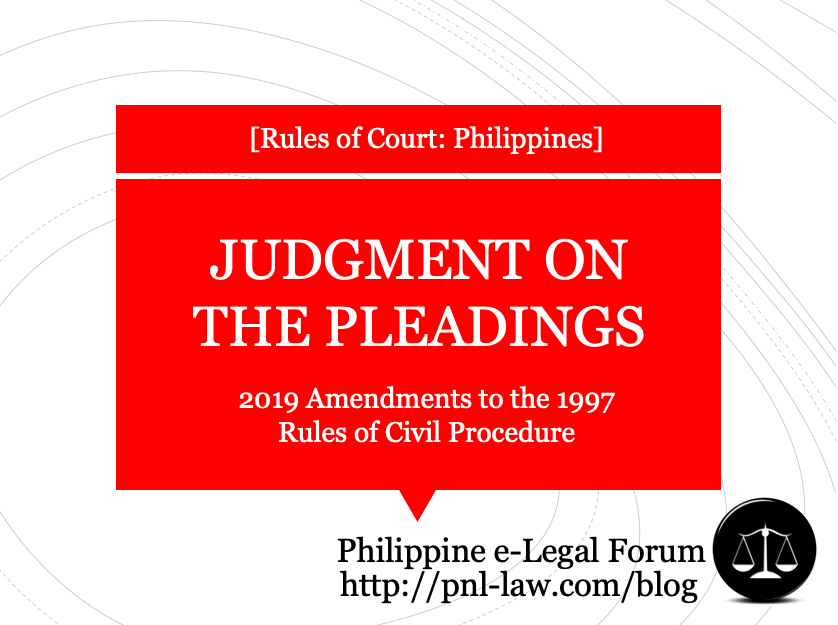The 2019 Proposed Amendments to the 1997 Rules of Civil Procedure (hereinafter, “2019 Amendments”), which takes effect on 1 May 2020, retains Section 1 of the provisions of Rule 34 (“Judgment on the Pleadings”). [The summary/discussion of other Rules may be tracked through the Menu.]

I. WHEN PROPER
Section 1 provides that the court, on motion of the adverse, may direct judgment on the pleadings if the Answer:
- fails to tender an issue, or
- otherwise admits the material allegations of the adverse party’s pleading
Section 1 also provides that there is a judgment on the pleadings is not available in actions for declaration of nullity or annulment of marriage. In such cases, the material facts alleged in the complaint shall always be proved.
The 2019 Amendments does not include an explanation of the phrase “fails to tender an issue”. An Answer would “fail to tender an issue” if it “does not deny the material allegations in the complaint or admits said material allegations of the adverse party’s pleadings by confessing the truthfulness thereof and/or omitting to deal with them at all. [Adolfo vs. Adolfo, G.R. No. 201427, 18 March 2015]
II. ADDITIONAL PROVISIONS
A new Section 2 has been added in the 2019 Amendments. Both sections, when read together, provide that:
- The adverse party may file a motion for judgment on the pleadings. In such a case, the motion shall be subject to the provisions of Rule 15, including the new provision hearing is discretionary even for litigious motions. [See Rules in Motions]
- The court motu proprio may also render a judgment on the pleadings.
- Any action of the court on a motion for judgment on the pleadings shall not be subject of an appeal or petition for certiorari, prohibition or mandamus.
We note that the propriety of rendering judgment on the pleadings is one of the matters which must be considered by the court during the pre-trial conference. The court may, after the pre-trial conference, motu proprio issue an order submitting the case for judgment on the pleading. [See Pre-Trial Conference]
SUMMARY JUDGMENT VS. JUDGMENT ON THE PLEADINGS
The existence or appearance of ostensible issues in the pleadings, on the one hand, and their sham or fictitious character, on the other, are what distinguish a proper case for summary judgment from one for a judgment on the pleadings.
In a proper case for judgment on the pleadings, there is no ostensible issue at all because of the failure of the defending party’s Answer to raise an issue. Whether or not the issues raised by the Answer are genuine is not the crux of inquiry in a motion for judgment on the pleadings.
In the case of a summary judgment, issues apparently exist — i.e. facts are asserted in the complaint regarding which there is as yet no admission, disavowal or qualification; or specific denials or affirmative defenses are in truth set out in the answer — but the issues thus arising from the pleadings are sham, fictitious or not genuine, as shown by affidavits, depositions, or admissions. The crucial question is: are the issues raised by petitioners not genuine so as to justify a summary judgment?
[Source: Wood Technology Corp. vs. Equitable Banking Corp. (G.R. No. 153867, 17 February 2005) and Adolfo vs. Adolfo (G.R. No. 201427, 18 March 2015].
